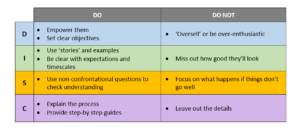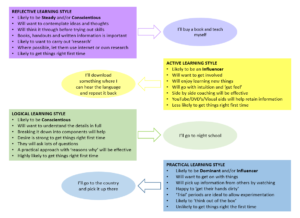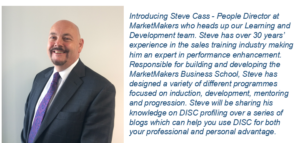Using DISC to manage people
“How many more times do I need to show you how to do that?”
“Why do you keep asking me the same questions?”
“I explained how to complete the report yesterday – so how did you get it wrong?”
These classic questions and thoughts go through every manager’s head, perhaps occasionally, but sometimes on a daily basis! We have found by using DISC when giving instructions we can easily avoid these scenarios. We know there are four different profiles (Dominant, Influencer, Steady and Conscientious) so, there will always be four different ways to give instructions. When it comes to giving somebody directions most managers will use their own DISC style to determine how those directions are delivered. If the recipient matches that DISC profiles then it’s likely to work, whereas if they have a different profile then the message will be less effective. This does not necessarily mean that it will go wrong although you may find the message has to be repeated.
So let’s look at how we ask people to do things in a way that may actually work first time!
Let’s start with our Dominant profile… We know that the Dominant personality doesn’t like or appreciate a fluffy approach so the first thing we need to do before issuing instructions to our “D” is ensure we have all the facts and be very clear about what the outcome of the direction will be. i.e. the objectives.
When it comes to the Influencer they are not going to hear the details so ensure you back up the instructions with an e-mail or handout. Also make sure you explain what they will personally gain from successfully completing the task.
The Steady profile is going to respond well to a supportive approach – it’s all about team work. You will find that by explaining what the impact of a successful outcome will be on the client, the team, or even yourself will create the desire within the Steady profile to want to do a great job.
So, no great surprises here as when it comes to the Conscientious profile it will be flow-charts and processes all the way! Be logical and provide step-by step instructions and you won’t go wrong.
Delivery of your instructions will also need to be tailored – so I have put together a grid on what to do and what to avoid doing!

When instructing people, we also need to consider how they process the information provided.
So here’s a fun way of understanding how we like to process information! Just ask the person “If you were to learn a new language, how would you go about it?” Generally, the answers will fall into one of these four categories:
- I’ll buy a book and teach myself
- I’ll download something where I can hear the language and repeat it back
- I’ll go to night school
- I’ll go to the country and pick it up there
These four answers will help us understand which of the four learning styles we can apply – this way the instructions you give can then be adapted to increase impact and effectiveness. Don’t be surprised if a person gives a combination of the answers – as an adult our learning styles adapt and develop – the key is to understand which ones they miss out as if you use that style then the effectiveness of your instruction is reduced. Also be aware that each style does not naturally link to a specific DISC profile.
Once we have the answer to our question we can then start to consider how we can introduce other elements to give instructions and knowledge…

And that’s it for this blog! It’s now over to you to try these techniques out and become an awesome and effective leader!
Next time we are going to explore how we take our dreams and aspirations and turn them into reality by motivating ourselves and planning in a way that matches our DISC profile.
So, I will leave you with a question to ponder in readiness for next time; what is it that you want to achieve in 12 months from now?
If you truly want this to happen you cannot afford to miss the next blog because DISC will make it happen.
See you next time!!

Tags: B2B Marketing, DISC, DISC Profiling, Disc Profiling Blogs, Learning and Development, Learning styles

